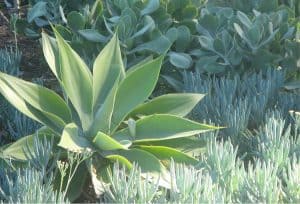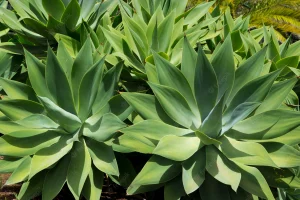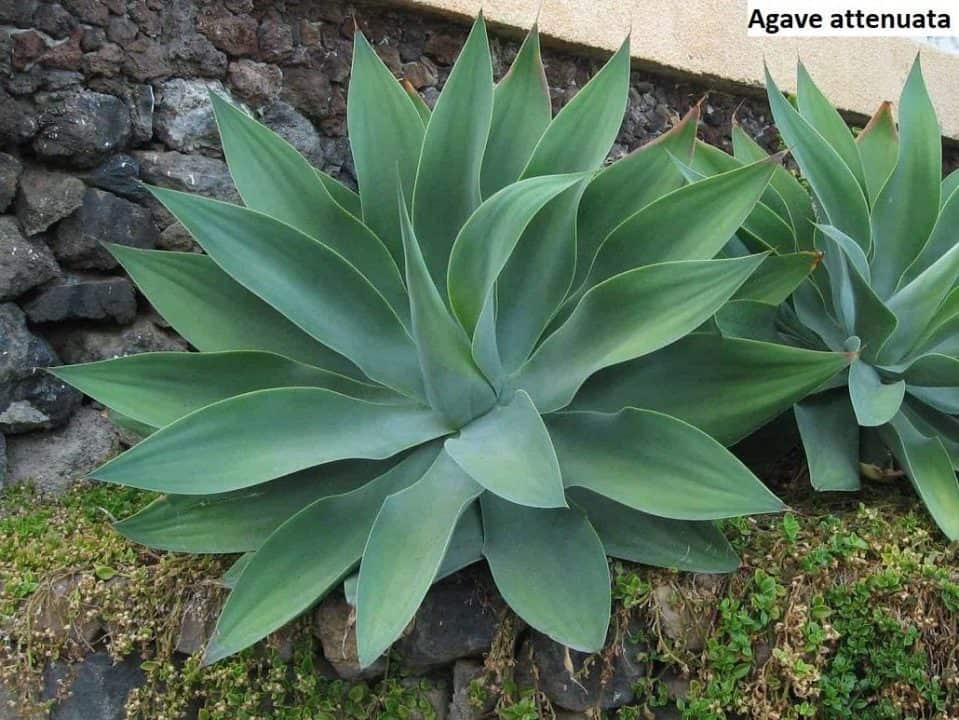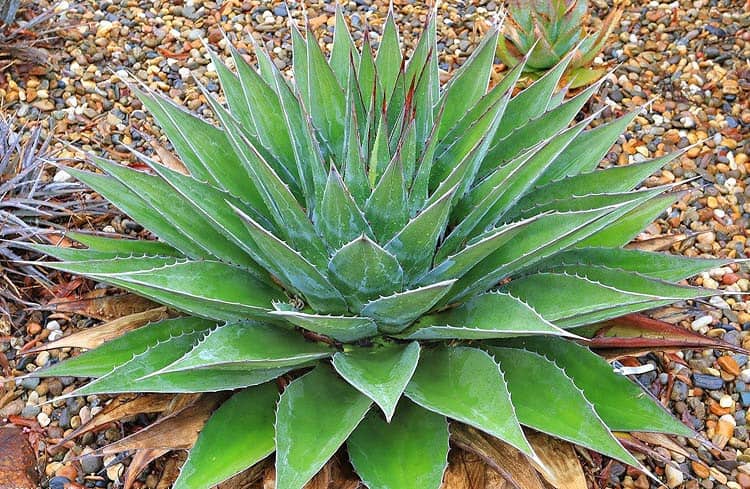Agave attenuata, also known as the spike plant, foxtail agave plant, or fox tail agave plant, is an excellent plant to add to your home or office if you want something that will thrive in low light and can also double as a conversation piece! This plant looks very similar to its cousin, Agave americana, which has leaves that spiral up and outwards from the center of the plant.
Agave attenuata, however, have leaves that fan out from the base of the plant in all directions with pointy ends. This can make it look much more like a fox tail than its other agave cousins.
Agave attenuata have beautiful flower stalks that protrude out of the center of the plant, giving it its unique name.
This plant is native to Arizona and can survive in U.S. Department of Agriculture hardiness zones 8 through 11, making it an excellent choice for anyone living in that region who wants to add a touch of natural beauty to their home’s landscape.
Origin and distribution
Native to southwestern North America, agave attenuata is common in California, Arizona, and New Mexico, where it can be found growing in the wild on rocky hillsides. It is easy to grow indoors and makes an interesting and unusual addition to any houseplant collection.
It is extremely hardy and can survive cold temperatures down to −6°C. A potted agave is a great addition to a rock garden or any landscape where moisture retention is needed. In colder regions, container-grown plants should be protected from hard frost in winter by bringing them indoors or wrapping them with bubble plastic or burlap until spring.
Agave attenuata propagation

While many plants can be propagated by seed, cutting, or budding, Agave attenuata are a little different in that they propagate by offsets. Offsets are baby plants that grow on or around mature agaves, and eventually, break off and fall to the ground where they can root themselves. They can also be cut from mature agaves and grown on their own roots in containers.
There are two ways to do so: You can either bury them in potting soil with only a few leaves exposed, or you can plant them directly into your garden as long as you keep them well-watered until they’re established. Either way, once your new plant is established it will begin producing its own offsets for future propagation.
Just remember to water regularly during dry spells. Once you get going, you can expect your Agave attenuata plant to produce one or more offsets every year. Be sure not to remove these offsets until they have developed at least one leaf of their own. If you try to remove them too early, they may die before becoming established plants of their own.
Also, make sure to give your young plants plenty of room; while you can keep smaller ones in small pots, larger ones need space to spread out. Keep in mind that if left unchecked, large agaves can reach an impressive size of over 30 feet tall! In fact, they’ve been known to become even larger than that, some individuals reportedly reaching up to 40 feet tall!
Agave attenuata care information

The agave attenuata, or fox tail agave plant, is a succulent that can grow up to five feet in height. Although it looks similar to a yucca plant, it is more closely related to lilies and cacti. When caring for your fox tail agave plant, you should water it sparingly and fertilize it rarely—this will help it keep its leggy appearance.
Light requirement
Like most agaves, fox tail agave requires full sun. Though it can withstand partial shade, you’ll need to supplement lighting during winter months when days are shorter and nights are cooler.
Place your plant in an area where it will receive about five hours of direct sunlight daily. The more light it receives, the faster it will grow. If you’re unable to provide adequate light for your plant, consider placing a grow light near its pot or moving it outdoors if possible.
Soil/potting mix
Agave attenuata do best when they are planted in loose, well-draining soil. In their native habitat, they will be planted in sandy or rocky soil, so a mix of 50% potting soil and 50% sand works well.
Because fox tail agaves grow in arid habitats where water isn’t readily available, they have evolved with deep roots that allow them to access groundwater far below ground level. The soil should always remain moist but never wet for optimal growth; watering once every three days should suffice.
Watering
As with any other kind of agave, Agave attenuata will benefit from a steady supply of water during its growing season, between April and October in U.S. Department of Agriculture plant hardiness zones 8 through 11. In particularly hot climates, it’s advisable to place your plant in an area where it will receive some partial shade throughout these months to help ward off any potential heat stress on the plant itself.
This plant prefers soil that is slightly drier than that of most other succulents. Give it ample water when it’s actively growing and less when it’s not, which in most cases is around wintertime. Water slowly over several hours so your plant has plenty of time to absorb what it needs without becoming waterlogged. Once the soil reaches its saturation point, leave no more than 10 percent dry.
Fertilizer
The agave attenuata is not a typical houseplant that needs to be fertilized regularly. On occasion, you can fertilize it with something light, like rose food. It’s important not to use too much fertilizer; one-quarter teaspoon of liquid fertilizer or 5 grams of dry fertilizer should be sufficient. Fertilizing more than that could burn your plant and actually prevent it from growing well.
Use sparingly if you feel yours needs it, and add only half of what is recommended on your fertilizer’s packaging label. Keep in mind that any fertilizer you use can run off into nearby water sources. If your plants are going to be near water, try organic fertilizers instead.
Temperature
Agave attenuata plants can withstand temperatures below 28 degrees Fahrenheit. In order to keep your Fox tail agave plant healthy, it is important that you protect it from freezing temperatures.
You should also try to avoid overwatering, which can cause root rot in extreme temperatures. In addition, make sure you do not place your agave outside during a freeze and never bring it inside during the winter months.
Humidity
The agave attenuata grows best in arid or semi-arid areas where it can easily collect and retain water from rain or other sources of water. Its ability to survive in such an environment comes from its leaves, which have a low surface area that prevents moisture loss.
This characteristic allows moisture to stay within them for a long time. The stems and roots also contain a sugary substance called saponin, which protects against heat stress.
The ideal humidity range is between 20 and 40 percent. In a dry environment, it’s important to water your agave attenuata regularly to keep its leaves from shriveling up. If you notice that your plant’s leaves are starting to wilt, it may be time for a little extra water.
Pruning
Keeping your agave houseplant in good shape requires proper care and pruning. While there are many ways to go about it, we recommend a two-pronged approach: At least once a year, remove all dead leaves, flowers, or other debris from its base.
This allows light and air to reach their roots. In addition, you’ll want to trim off any long spikes that aren’t in bloom – especially as they begin curling back toward themselves.
When to repot

Agave attenuata are drought-tolerant plants and are not susceptible to overwatering, but they will start to look a little droopy if kept in a pot for too long. Depending on how large your plant is, you can expect it to need repotting every couple of years. The best time to repot an agave is when it’s actively growing—in spring or summer.
The ideal time for transplanting a mature agave is right after flowering has ended when new growth begins. If your plant has been in its current container for at least two years, then now might be a good time to think about moving it into something larger.
Dormancy
Like any other plant, fox tail agaves require dormancy. They should be kept in a cool room or garage during winter. The ideal temperature is 40-60 degrees Fahrenheit with little light.
The soil should be kept moist at all times so that it doesn’t dry out and cause harm to your plant when it comes back into growth after dormancy. Some growers will place their plants on top of heating pads to keep them warm enough while they are dormant.
Fox tail agave flower & fragrance
Agave attenuata blooms in early spring, sometimes before you can see leaves appear. Blooms are roughly 3 inches wide and 3-4 inches tall. Flowers tend to be pale yellow with streaks of red/orange, but plants are known to produce very strange-colored flowers as well.
The fragrance is reported to smell like a combination of orange blossoms and bubblegum, although many people claim it smells much more strongly like cucumber than anything else.
Agave attenuata growth rate
The fox tail agave plant is a slow-growing plant. It will only grow up to two or three feet in its first year. Once it reaches maturity, however, it will be able to grow as tall as 8–12 feet. The more room you give your agave plants, the faster they’ll grow; therefore it’s best to transplant a young fox tail agave in order for it to reach full maturity.
Toxicity
As part of its natural defense mechanism, agave attenuata produce needle-like crystals of calcium oxalate that can irritate skin and mucous membranes. Plants may have varying degrees of toxicity.
One bite generally has little or no effect but if chewed thoroughly it can cause a burning sensation in the mouth and throat, difficulty swallowing, numbness or tingling in lips, tongue, and/or face; or even vomiting. Swallowing plant matter can result in abdominal pain, nausea, vomiting, and diarrhea.
USDA Hardiness Zones
Agave attenuata thrives in USDA Hardiness Zones 9 through 11. It can be grown as an indoor plant anywhere else.
Pests and diseases
Fox tail agaves are fairly hardy, but they may occasionally fall victim to Mealybug, Aphids, and Scale. The best way to keep your agave healthy is by providing good airflow and sufficient light. In addition, be sure that you plant it in a location with well-draining soil; excess water can lead to root rot. We recommend consulting with a local gardening center for specific information on pests and diseases in your area.
Conclusion
Like most of its species, Agave attenuata is a succulent plant, meaning it stores water inside its fleshy leaves. This makes it well-suited for a desert environment, where growing conditions are often harsh and unpredictable.
It is recommended that owners of a fox tail agave plant place it outside in the full sun and provide it with at least one inch of water per week to keep these leaves filled with liquid.

